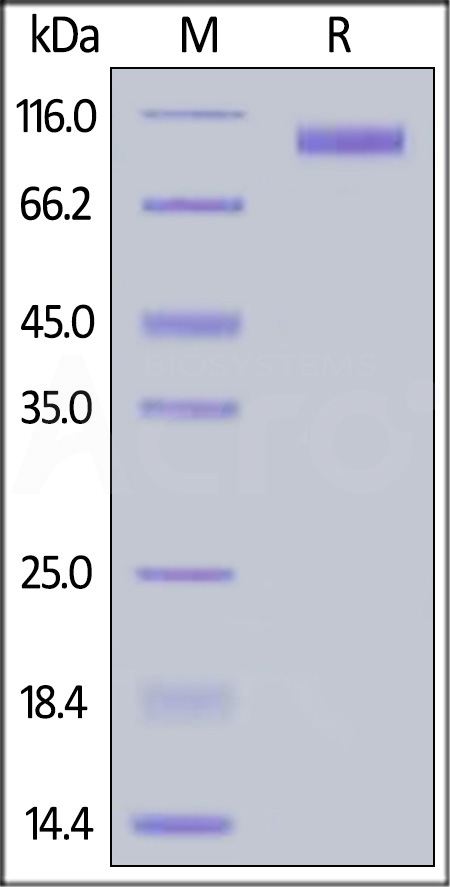分子别名(Synonym)
SIGLEC5,OB-BP2,CD170,CD33L2
表达区间及表达系统(Source)
Human Siglec-5, Fc Tag (SI5-H5250) is expressed from human 293 cells (HEK293). It contains AA Glu 17 - Thr 434 (Accession # AAH29896).
Predicted N-terminus: Glu 17
Request for sequence
蛋白结构(Molecular Characterization)

This protein carries a human IgG1 Fc tag at the C-terminus.
The protein has a calculated MW of 73.0 kDa. The protein migrates as 90-110 kDa under reducing (R) condition (SDS-PAGE) due to glycosylation.
内毒素(Endotoxin)
Less than 1.0 EU per μg by the LAL method.
纯度(Purity)
>95% as determined by SDS-PAGE.
制剂(Formulation)
Lyophilized from 0.22 μm filtered solution in Tris with Glycine, Arginine and NaCl, pH7.5. Normally trehalose is added as protectant before lyophilization.
Contact us for customized product form or formulation.
重构方法(Reconstitution)
Please see Certificate of Analysis for specific instructions.
For best performance, we strongly recommend you to follow the reconstitution protocol provided in the CoA.
存储(Storage)
For long term storage, the product should be stored at lyophilized state at -20°C or lower.
Please avoid repeated freeze-thaw cycles.
This product is stable after storage at:
- -20°C to -70°C for 12 months in lyophilized state;
- -70°C for 3 months under sterile conditions after reconstitution.
质量管理控制体系(QMS)
电泳(SDS-PAGE)

Human Siglec-5, Fc Tag on SDS-PAGE under reducing (R) condition. The gel was stained with Coomassie Blue. The purity of the protein is greater than 95%.
 +添加评论
+添加评论
- 176XXXXXXX8
- 这个蛋白算是比较冷门的靶点了,试着自己表达纯化,但是纯度都很低,无法开展试验。Acro家的siglec5这款蛋白纯度高,效价高,非常好的解决了我的问题。已经是Acro'的老用户了,蛋白质量好,货期短。
- 2024-6-4
背景(Background)
Sialic acid-binding Ig-like lectin 5 (SIGLEC5) is also known as CD33 antigen-like 2 (CD33L2), Obesity-binding protein 2 (OB-BP2), CD antigen CD170, which belongs to the immunoglobulin superfamily and SIGLEC (sialic acid binding Ig-like lectin) family. SIGLEC5 / CD170 is expressed by monocytic / myeloid lineage cells. SIGLEC-5 / CD33-L2 binds equally to alpha-2,3-linked and alpha-2,6-linked sialic acid. The sialic acid recognition site may be masked by cis interactions with sialic acids on the same cell surface.























































 膜杰作
膜杰作 Star Staining
Star Staining












 Loading ...
Loading ...




